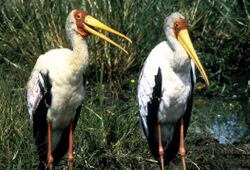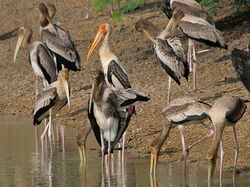Biology:Mycteria
| Mycteria Temporal range: Middle Miocene to Recent
| |
|---|---|

| |
| Yellow-billed storks (Mycteria ibis) | |
| Scientific classification | |
| Domain: | Eukaryota |
| Kingdom: | Animalia |
| Phylum: | Chordata |
| Class: | Aves |
| Order: | Ciconiiformes |
| Family: | Ciconiidae |
| Genus: | Mycteria Linnaeus, 1758 |
| Type species | |
| Mycteria americana (wood stork) Linnaeus, 1758
| |
| Species | |
| |
| Synonyms | |
| |
Mycteria is a genus of large tropical storks with representatives in the Americas, east Africa and southern and southeastern Asia. Two species have "ibis" in their scientific or old common names, but they are not related to these birds and simply look more similar to an ibis than do other storks.
The Mycteria storks are large birds, typically around 90–100 cm in length with a 150 cm wingspan. The body plumage is mainly white in all the species, with black in the flight feathers of the wings. The Old World species have a bright yellow bill, red or yellow bare facial skin and red legs, but these parts are much duller in the wood stork of tropical America. Juvenile birds are a duller version of the adult, generally browner, and with a paler bill.
They are gregarious broad-winged soaring birds that fly with the neck outstretched and legs extended. They are resident breeders in lowland wetlands with trees in which they build large stick nests. Most species of Mycteria are diurnal, except for M. americana, which may be nocturnal.[1]
These storks walk slowly and steadily in shallow open wetlands seeking their prey, which, like that of most of their relatives, consists of fish, frogs and large insects.
Distribution
The genus Mycteria inhabits all tropical regions of the Earth. M. americana is distributed throughout the American continent. M. ibis lives in tropical Africa. M. leucocephala is present in eastern Pakistan and India to Vietnam, and M. cinerea in Cambodia and Vietnam to Sumatra and Java.[2]
Taxonomy
The genus Mycteria was introduced in 1758 by the Swedish naturalist Carl Linnaeus in the tenth edition of his Systema Naturae for the wood stork (Mycteria americana) which is therefore now the type species.[3][4] The genus name is from the Ancient Greek μυκτηρ/muktēr meaning "snout" or "nose".[5]
Species
The genus contains four species.[6]
| Image | Scientific name | Common Name | Distribution |
|---|---|---|---|

|
Mycteria americana | Wood stork or "wood ibis" | South America, Central America, Mexico, the Caribbean, Florida and coastal southeastern United States |

|
Mycteria ibis | Yellow-billed stork | Senegal and Somalia down to South Africa and in some regions of western Madagascar |

|
Mycteria leucocephala | Painted stork | south of the Himalayan ranges and are bounded on the west by the Indus River system where they are rare and extend eastwards into Southeast Asia |
 |
Mycteria cinerea | Milky stork | Southeast Asia |
Fossils
Two prehistoric relatives of the wood stork have been described from fossils:
- † Mycteria milleri (Miller's stork) (Valentine Middle Miocene of Cherry County, US) - formerly Dissourodes
- † Mycteria wetmorei (Wetmore's stork) (Late Pleistocene of west and southeast US, and Cuba)
The latter seems to have been a larger sister species of the wood stork, which it replaced in prehistoric North America.[7]
Late Miocene tarsometatarsus fragments (Ituzaingó Formation at Paraná, Argentina) are somewhat similar to Mycteria but still distinct enough to be probably a distinct genus, especially considering their age.[8][9] A Late Pleistocene distal radius from San Josecito Cavern (Mexico) may belong in this genus or in Ciconia.[10] A "ciconiiform" fossil fragment from the Touro Passo Formation found at Arroio Touro Passo (Rio Grande do Sul, Brazil ) might be of the living species M. americana; it is at most of Late Pleistocene age, a few ten thousands of years.[11]
References
- ↑ DEL HOYO, J.; ELIOTT, A. e SARGATAL, J (Eds.). 1992 - Handbook of the birds of the world. Lynx, Barcelona. 879p.
- ↑ Kahl, M. P. (January 1971). "Food and feeding behavior of Openbill Storks". Journal für Ornithologie 112 (1): 21–35. doi:10.1007/bf01644077. ISSN 0021-8375. http://dx.doi.org/10.1007/bf01644077.
- ↑ Linnaeus, Carl (1758) (in Latin). Systema Naturae per regna tria naturae, secundum classes, ordines, genera, species, cum characteribus, differentiis, synonymis, locis. 1 (10th ed.). Holmiae (Stockholm): Laurentii Salvii. p. 140. https://www.biodiversitylibrary.org/page/727047.
- ↑ Mayr, Ernst; Cottrell, G. William, eds (1979). Check-List of Birds of the World. 1 (2nd ed.). Cambridge, Massachusetts: Museum of Comparative Zoology. p. 245. https://www.biodiversitylibrary.org/page/16108885.
- ↑ Jobling, James A. (2010). The Helm Dictionary of Scientific Bird Names. London: Christopher Helm. p. 263. ISBN 978-1-4081-2501-4.
- ↑ Gill, Frank; Donsker, David; Rasmussen, Pamela, eds (July 2021). "Storks, frigatebirds, boobies, darters, cormorants". IOC World Bird List Version 11.2. International Ornithologists' Union. https://www.worldbirdnames.org/bow/storks/.
- ↑ Suarez, William; Olson, Storrs L. (2003). "New Records of Storks (Ciconiidae) from Quaternary Asphalt Deposits in Cuba". Condor 105 (1): 150–154. doi:10.1650/0010-5422(2003)105[150:NROSCF2.0.CO;2]. https://www.researchgate.net/publication/232669679.
- ↑ Cione, Alberto Luis; de las Mercedes Azpelicueta, María; Bond, Mariano; Carlini, Alfredo A.; Casciotta, Jorge R.; Cozzuol, Mario Alberto; de la Fuente, Marcelo; Gasparini, Zulma; Goin, Francisco J.; Noriega, Jorge; Scillatoyané, Gustavo J.; Soibelzon, Leopoldo; Tonni, Eduardo Pedro; Verzi, Diego & Guiomar Vucetich, María (2000): Miocene vertebrates from Entre Ríos province, eastern Argentina . In: Aceñolaza, F.G. & Herbst, R. (eds.): El Neógeno de Argentina. INSUGEO Serie Correlación Geológica 14: 191-237.
- ↑ Noriega, Jorge Ignacio & Cladera, Gerardo (2005): First Record of Leptoptilini (Ciconiiformes: Ciconiidae) in the Neogene of South America . Abstracts of Sixth International Meeting of the Society of Avian Paleontology and Evolution: 47.
- ↑ Steadman, David W.; Arroyo-Cabrales, Joaquin; Johnson, Eileen; Guzman, A. Fabiola (1994). "New Information on the Late Pleistocene Birds from San Josecito Cave, Nuevo León, Mexico". Condor 96 (3): 577–589. doi:10.2307/1369460. http://sora.unm.edu/sites/default/files/journals/condor/v096n03/p0577-p0589.pdf.
- ↑ Schmaltz Hsou, Annie (2007): O estado atual do registro fóssil de répteis e aves no Pleistoceno do Estado do Rio Grande do Sul, Brasil ["The current state of the fossil record of Pleistocene reptiles and birds of Rio Grande do Sul"]. Talk held on 2007-JUN-20 at Quaternário do RS: integrando conhecimento, Canoas, Rio Grande do Sul, Brazil.
Further reading
- Grimmett, Richard; Inskipp, Carol, Inskipp, Tim & Byers, Clive (1999): Birds of India, Pakistan, Nepal, Bangladesh, Bhutan, Sri Lanka, and the Maldives. Princeton University Press, Princeton, N.J. ISBN:0-691-04910-6
- Hilty, Steven L. (2003): Birds of Venezuela. Christopher Helm, London. ISBN:0-7136-6418-5
Wikidata ☰ Q1180273 entry
 |


